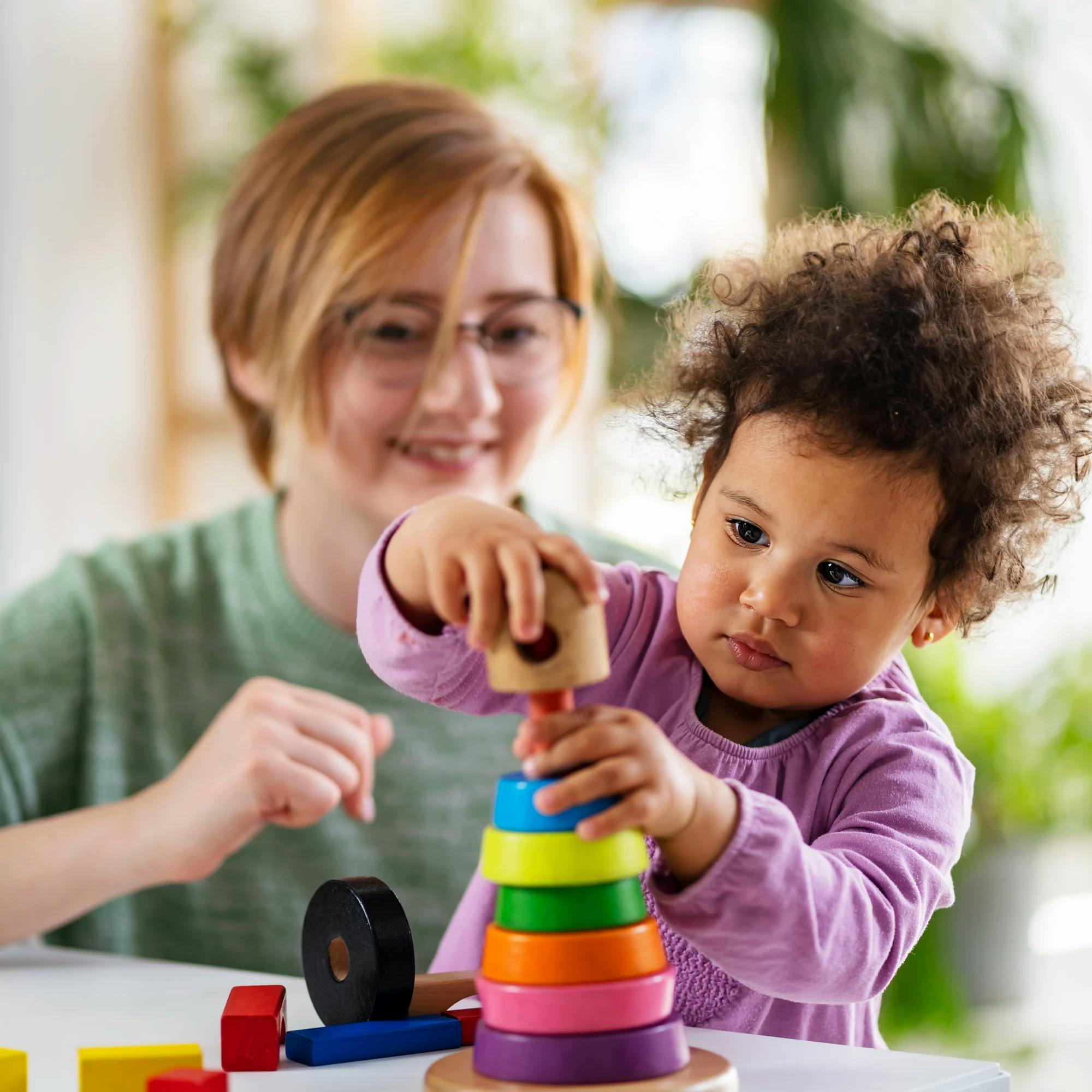
10 Ways to Help Autistic Children Improve Their Understanding of Language
 Alexis Irazoque, M.S., CCC-SLP
Alexis Irazoque, M.S., CCC-SLP
For some autistic people, language can be hard to understand. Autism can cause challenges with receptive language, which is all about comprehension: how we understand other people and the words we hear. Examples might include following directions or understanding questions.
In speech therapy, autistic children can build their receptive language skills and improve their communication and connection with others. Here are 10 recommended techniques you can try at home to help your child better understand language.
Personalized care for your child
We support autistic children for who they are and help them build new skills. Get matched with a licensed speech therapist today.
 Get started
Get started1. Encourage your child to communicate
Many autistic children prefer to play by themselves. Your toddler might seem perfectly happy playing on their own or watching their favorite videos.
However, it’s important to think ahead to when they start preschool or kindergarten. Your child will be in a more structured environment, with adults giving them verbal instructions. That’s one reason it’s smart to work on language skills during the toddler years. It helps prepare a child for the rest of their lives.
2. Keep your own language simple
Many parents think that when they use more complex “adult” language, their child will be more likely to use that language themselves. However, complex language may be too hard for a child to understand.
So, keep it simple. Phrases like “Throw the ball” or “Time for bath” are clear and direct. When you combine them with a gesture, that reinforces your message and makes it easier for your child to understand what you mean.


3. Use visual cues
A autistic child might appear to not be listening. They may have a hard time maintaining eye contact. Visual cues, or hints that your child can see, can be a great way to help them understand your message.
To do this, try combining words with the actual object you’re talking about. This visual cue can make a world of difference. For instance, when you give your child a choice of two snacks, hold each snack in your hands. Name them as you bring them close to your mouth. This reinforces the names of these objects so your child can better communicate what they want. Try saying: “Would you like the apple or the banana?” and then stating “You wanted the apple!” after they’ve made their choice.

4. Read lots of books together
Not only is reading a great activity to share with your child, but books also go a long way in improving receptive language. For a child who’s just starting to learn language, choose books with pictures that can be easily labeled. Books with features that kids can touch, like touch-and-feel books, can also engage a young child with autism.
Trying picking objects on each page to label and turn it into a game of “I Spy.” For example, you could say, “Do you see the cow that says moo?” or “Can you show me the cookie?” This activity can encourage early literacy skills as you work to increase your child’s understanding of language.


5. Use your child’s name often
Many parents of autistic children report that they don’t respond to their name. Using their name often can reinforce their awareness. This can motivate them to begin responding to their name when called.
Try saying, “All done with your snack, Kate?” or “Do you want ‘open,’ Isaac?” It may sound redundant, but it's a helpful way to strengthen a child’s recognition of their own name.
6. Narrate what's happening
Above all, we always want to provide kids with a language-rich environment. Even if a child prefers to play alone, you can take this opportunity to describe their actions out loud. Think of it as if you’re narrating a movie.
When you keep language simple, repetitive, and linked to visual cues, autistic children can often understand the meaning behind the words more easily.
You might say, “Oh, you’re stacking the blocks. Uh oh, they fell over! Can you try again? Stack them up, up up!” Or, if your child is watching something you’re doing, say, “I’m stirring the soup. I’m pouring it into a bowl. It is hot!”
Again, when you keep it simple, repetitive, and linked to visual cues (or things your child can see), autistic children can often understand the meaning behind the words more easily. This helps them learn receptive language skills without the pressure of having to follow directions or complete an activity.
7. Sing or listen to songs with gestures
While you might be losing your mind hearing "Baby Shark" on repeat, believe it or not, songs like this are a great way to increase receptive language. These types of childhood songs are simple and often use gestures and repetition to grow kids' language skills--which is exactly what we want!
Sure, listening to “Wheels on the Bus” multiple times in a row might not be your idea of fun. But think of all the language your child can learn by participating: “The doors on the bus go open and shut,” or “The people on the bus go up and down.”
Functional words like “open,” “shut,” “up,” and “down” are a foundation for understanding common verbal directions throughout the day, such as “Open the cupboard” or “Put down your backpack.” For an autistic child, songs like these can be a great way to tap into their receptive language skills.


8. Talk about the sounds your child hears
We live in a world that's rich with sounds. Taking the time to confirm what your child hears is an easy way to increase receptive language. For example, you could say, “I hear a dog bark! Did you hear that? Woof woof,” and then point to the dog you’re hearing.
Sirens, airplanes, and babies crying are all opportunities to link sounds with language and promote joint attention, which is a building block of communication. Talking about sounds is another easy way to use an everyday moment as a language-building opportunity.
9. Focus on the fundamentals
Functional language is the language that we use in day-to-day situations. Examples of functional language include common objects, people in your family, and favorite food or toys. Some parents focus on teaching children to label colors or letters. While this will be useful later on, it isn't as helpful when you want your child to follow simple directions, such as “Please get your shoes.”
Starting with basic, useful words, and building vocabulary from there, can help your child master the language needed for daily routines. This makes everyone’s life that much easier.
10. Play with your child
Children learn language through playing. Getting down on their level, playing alongside them, or letting them take the lead during an activity can motivate your child to participate.
Say you and your child are rolling a ball or a toy car back and forth. To build receptive language, you might say, “Here comes the car, beep beep!” or “I roll the ball to you.” These types of simple phrases help kids learn turn-taking, listening skills, and the names of objects.
By narrating each turn, and using gestures and simple words, you're increasing your child's ability to understand language--while strengthening your bond as you play together!
Speech therapy can help your autistic child with language skills
Speech-language pathologists are experts in supporting autistic children and their families.In fact, speech therapy is one of the most common therapies recommended for autistic people. Your speech therapist should identify your child’s current strengths and differences and create a personalized, affirming plan to grow their communication skills.
At Expressable, we provide online speech therapy to autistic children, teens, and adults across the country. You can learn more about our approach in our autism treatment guide. Multiple studies over several years have shown the effectiveness of online speech therapy for autistic people, including kids. Research has found that for autistic individuals and their families, online speech therapy works just as well as in-person therapy. In some cases, teletherapy works even better.
Click here to get matched with a speech therapist who’s experienced in supporting autistic children and their families.
FAQs about helping autistic children understand language
1 Does autism affect receptive language?
Autism can cause challenges with receptive language, which is how we understand other people and the words we hear. For instance, some autistic children have trouble following directions or understanding questions.
2 How can I help my autistic child understand language?
In general, it’s helpful to use simple language, repeat everyday words, and use visual cues. This will help your child better understand the meaning behind words. A speech therapist can recommend specific techniques that are best for your child.
3 How can I get my autistic child to respond to their name?
Use your child’s name often to increase their awareness of it. It may feel redundant, but it helps strengthen your child’s recognition of their own name and motivate them to begin responding to it.
4 Can speech therapy help an autistic child better understand language?
Speech therapy is one of the most common therapies recommended for autistic people. Your speech therapist will create a personalized plan to grow your child’s communication skills. Learn about Expressable’s approach in our autism treatment guide.
An important note: We believe that when speaking about any community as a whole, the best approach is to prioritize that community’s voices, needs, and preferences. Within the larger autism community, the current language preference is identity-first, which is why we use that language in our content. Expressable is committed to listening to and learning from the populations we serve. If and when their preferences change, we’ll adjust our approach accordingly.
How Expressable Can Help
Concerned your child isn't reaching age-expected milestones? Looking for communication support from a professional? Expressable is a national online speech therapy practice serving children and adults. We treat all major areas of communication and feeding, offer flexible hours including evenings and weekends, and accept most major health insurance plans. We’re proud to have earned more than 3,000 5-star reviews from our clients (4.9/5 average).
Our therapy model is centered on parent and caregiver involvement. Research proves that empowering caregivers to participate in their loved one’s therapy leads to better outcomes. That’s why we combine live, 1-on-1 speech therapy with personalized education and home practice activities for faster progress.
Communication is more than words. It’s how we share how we feel and show who we are. We’re here to help you or your child do just that.











